Reality is individuals all the way down.
The Magick of Baphomet
The understanding of the Law of Thelema with its demands and rewards gives one the best possible chance to make the most of a human life.
The Divine Individual
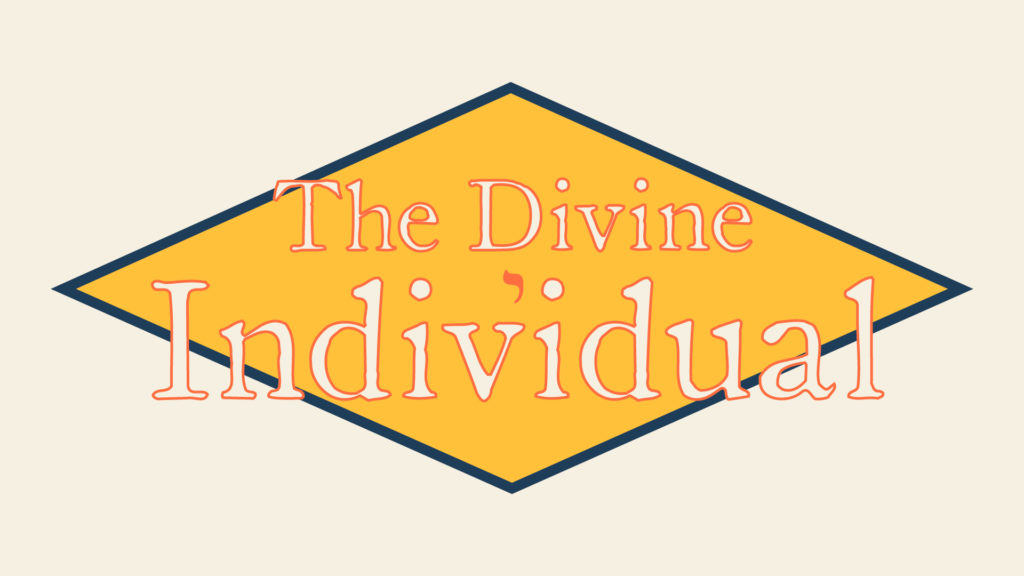
Part 4 of the Dualism, Monism & Thelema series
Having established the relationship between Nuit, Hadit, and the Qabalistic Zero, let’s now look at the relationship between Nuit and Hadit, in combination, and the Star.
The Definition of a Star
After introducing Nuit and Hadit as the “elements” of the Thelemic Universe, Crowley then introduces the concept of the Star, defining it as the combination of Nuit and Hadit.
Every event is a uniting of some one monad with one of the experiences possible to it.
“Every man and every woman is a star,” that is, an aggregate of such experiences, constantly changing with each fresh event, which affects him or her either consciously or subconsciously.
Crowley, “Introduction” to the Book of the Law
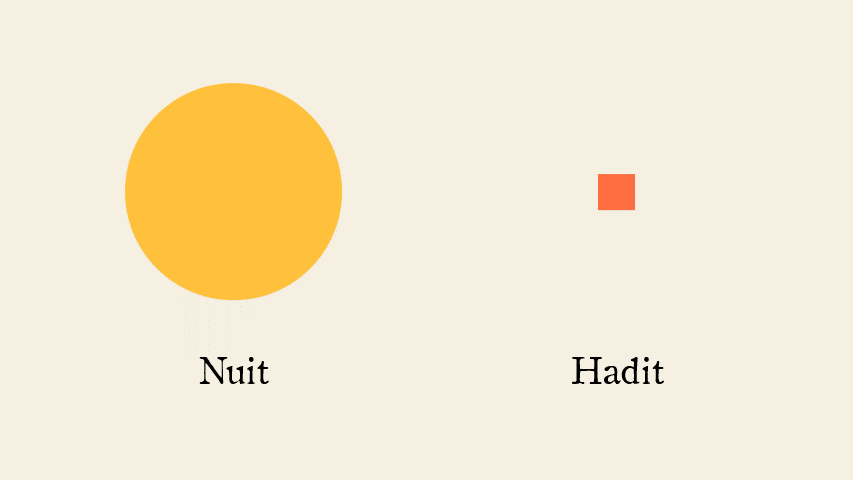
On the one hand, we have the monad, which Crowley previously identifies with Hadit or the subjective point of view. It is “that to which all Events occur.” (DC on AL II.2) It unites with Nuit, the “total of possibilities of every kind,” thereby eliciting one of the possible experiences latent within Her.

The change from one experience to another is defined as an event. The Star is defined as the aggregate of such experiences that occur to any one particular monad.

As the Star is defined as the occurrence to Hadit of some set of possibilities latent within Nuit, the Star is unintelligible without Nuit and Hadit.
Hadit seems to be the principle of Motion which is everywhere, yet is not extended in any dimension except as it chances to combine with the “Matter” which is Nuit. There can evidently be no manifestation apart from this conjunction. A Khabs or Star is apparently any nucleus where this conjunction has taken place.
New Comment on AL II.2 (emphasis mine)
This aggregate of experiences occurring to Hadit is further defined as the essence of each individual.
Every man and every woman is a star.
AL I.3
This ‘star’ or ‘Inmost Light’ is the original, individual, eternal essence.
New Comment on AL I.8
It is also linked with the figure of Ra-Hoor-Khuit.
We have seen that Ra-Hoor-Khuit is in one sense the Silent Self in a man, a Name of his Khabs, not so impersonal as Hadit, but the first and least untrue formulation of the Ego.
New Comment on AL III.62
This passage suggests there are other senses in which Ra-Hoor-Khuit does not mean the Silent Self or Khabs of an individual. It is possible Crowley is referring to his prior commentary on AL III.22:
Ra-Hoor-Khuit, like all true Gods, is therefore a Solar-Phallic deity. But we regard Him as He is in truth, eternal […] Ra-Hoor-Khuit is the Crowned and Conquering Child. This is also a reference to the ‘Crowned’ and Conquering ‘Child’ in ourselves, our own personal God
New Comment on AL III.22 (emphasis mine)
In this passage Crowley appears to distinguish between Ra-Hoor-Khuit as a general deity or archetype versus His manifestation as a particular Star. As we will see in a moment, he makes a similar distinction between Nuit and Nuith and Hadit and Hadith.
From this further information we may conclude that Star, Khabs, Silent Self, Ra-Hoor-Khuit (at least “in one sense,” as the personal God of each individual), and the essence of each individual are equivalent, interchangeable terms. They are only rationally distinct from one another. And the condition of intelligibility of any of them is the conjunction of Nuit and Hadit.
The Distinction between the Star and Nuit and Hadit
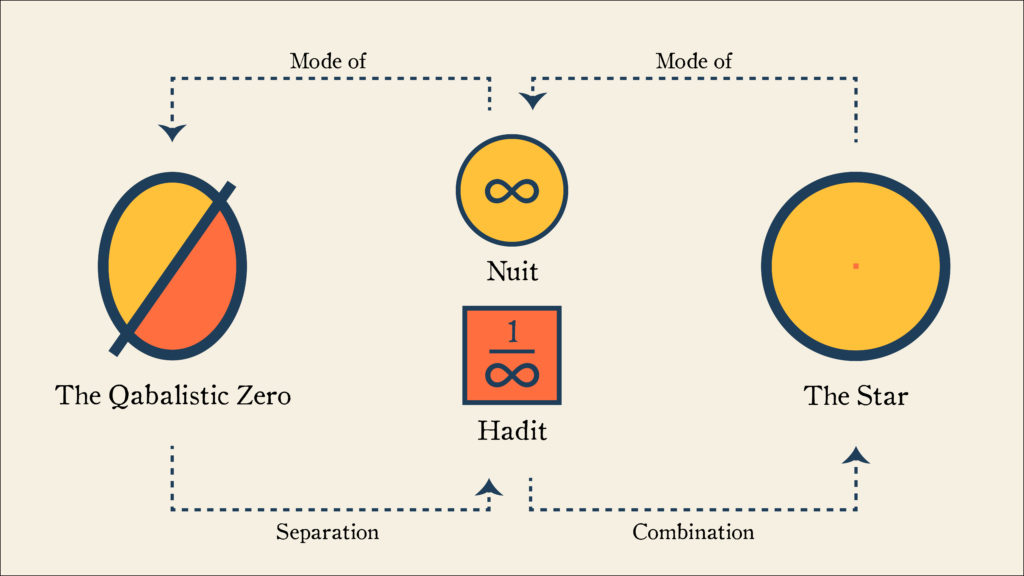
While the Star is unintelligible in the absence of Nuit and Hadit, the reverse is not true. Nuit and Hadit are each intelligible in the absence of the concept of the Star. This follows from Nuit and Hadit being modally distinct in the type-b sense.
To review, any two things, x and y, which are modally distinct in the type-b sense are intelligible independently of one another (in other words they are prima facie separate substances), but they share a common third condition, z.
Since we have already discovered that the common condition of Nuit and Hadit is the Qabalistic Zero, it cannot be the case that the Star (or anything else) could be their common condition. Ergo, Nuit and Hadit are each intelligible absent the Star.
It might be averred that Nuit and Hadit are in some sense compelled by their natures to combine and form Stars, and therefore Stars necessarily follow from Nuit and Hadit existing. As Crowley says
[Nuit and Hadit] can only realize Themselves by creating an infinite variety of forms of Themselves, each one real as it is Their image, illusory as it is a partial and divided aspect of Them.New Comment on AL I.29 (emphasis mine)
But the question is not how Nuit and Hadit realize themselves. Again, our concept of substance leaves aside questions of existence and only deals with questions of intelligibility. The question is whether we can even conceive of them separately from Stars (and therefore, by definition, separately from one another), and that’s exactly what we did in the previous section when we realized they were distinct modes of the Qabalistic Zero.
Since Stars are only intelligible with reference to Nuit and Hadit but not vice versa, it follows that any Star is modally distinct from Nuit and Hadit.
Monism and the Star
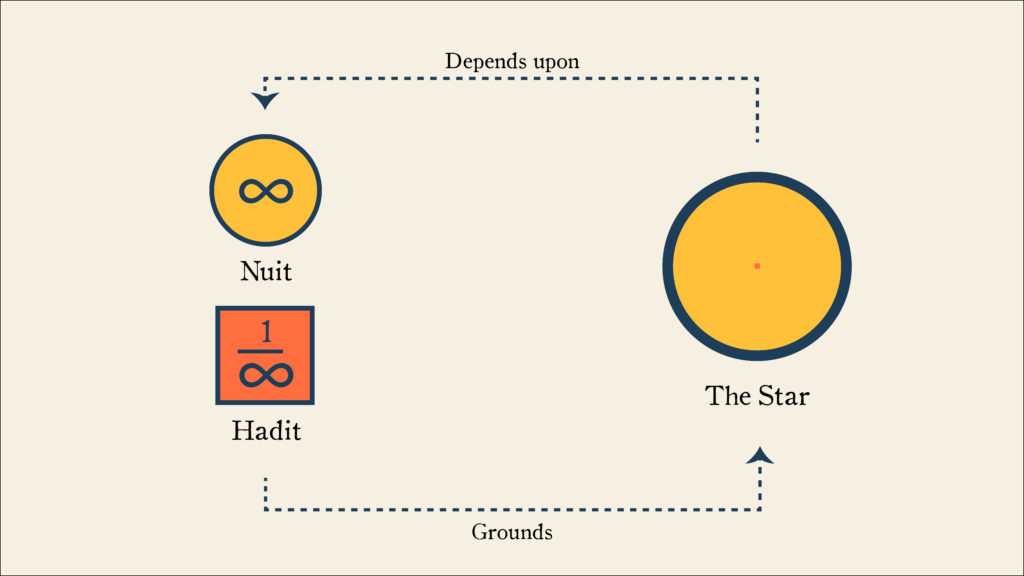
Since Stars depend for their intelligibility on Nuit and Hadit (and not vice versa), it follows we are dealing with another case of dependence monism. We cannot speak about Stars entirely separately from Nuit and Hadit, since each Star is dependent upon Nuit and Hadit for its own intelligibility. But we can speak intelligibly about Stars as distinct from Nuit and Hadit, as Crowley does in the following passage.
Each such Star is intelligible to Them [Nuith and Hadith], as a poem is to its author as a part of this soul mirrored by his mind. But it is not intelligible to itself, because it has no relation with any other ideas; it only knows itself as the babe of its mother Nuith, to whom it yearns, being stirred by its father Hadith to express that instinctive attachment by inarticulate cries.
Ibid.
The names Nuith and Hadith do not appear in the Book of the Law, but Crowley tends to use them in the commentaries when speaking of Nuit and Hadit from the most abstract point of view. I will follow his usage.
This passage demonstrates that Crowley speaks of Nuit(h) and Hadit(h) in terms that indicate both their separation and connection to Stars in a way which we are defining as modal or a relationship of dependence monism. Yet this passage further determines the type of monism holding between Nuith, Hadith, and Stars.
Stars are intelligible to Nuith and Hadith. This is exactly what we would expect from a relationship of dependence monism where Nuith and Hadith are ground, and the Star is their consequent. The relationship of author (Nuith/Hadith) to poem (Star) implies that the nature of each Star is transparent to Nuith and Hadith. Crowley further determines this relationship of intelligibility by comparing Nuith and Hadith to the idea of a triangle and the Star to an actual triangle.
For no triangle can express the idea of a triangle. Any triangle must be either equilateral, isosceles or scalene, either acute, right-angled, or obtuse; and no one triangle can be all these at once; while the idea of a triangle includes all these, and infinite other, possibilities.
Ibid.
The way Crowley describes the relationship between the idea of a triangle and (actual) triangles is what we have been calling a modal distinction. As everything that can be proved about any particular triangle has its ground in the idea of a triangle, so do all things that follow from a particular Star have their ground in Nuith and Hadith. From this we may gather that Nuith and Hadith serve as a kind of paradigm or Platonic Idea of Stars in general.
In the language we have developed up to this point, we would call this an instance of derivation monism. Not only do all Stars depend upon Nuith and Hadith for their intelligibility. The meaning of each Star ultimately reduces to some meaning latent within Nuith and Hadith themselves. In other words, a complete understanding of Nuith and Hadith would, by analysis, reveal each and every Star, its particular position in space, its relations to all other Stars, and the experiences each and every Star would ever go through.
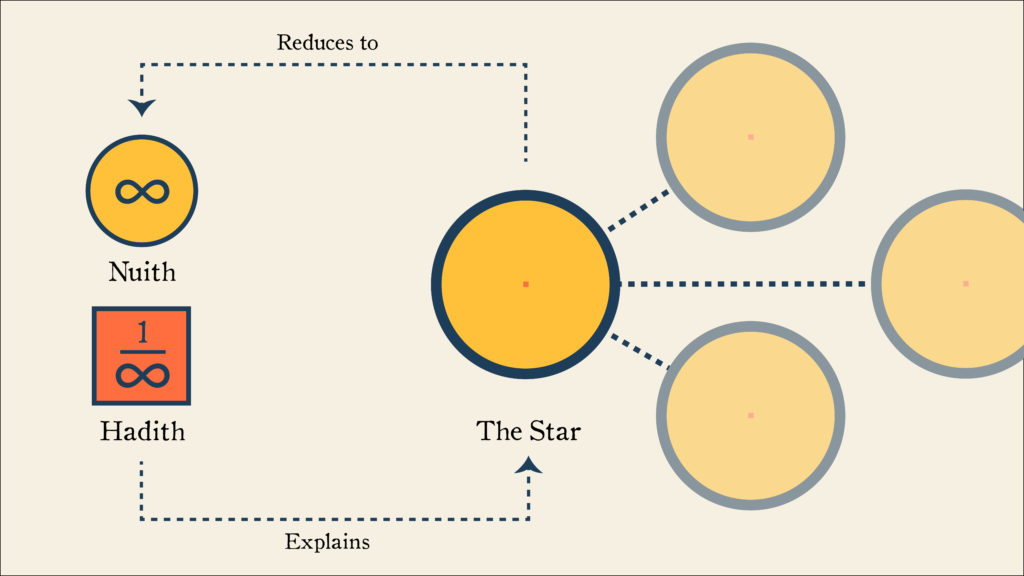
From the level of Nuith and Hadith, the entire Thelemic Universe is, at least in principle, computable. Theoretically there exists an algorithm which exhaustively explains each and every Star, its relationships to all other Stars, and all of its experiences.
However, in the very same passage where Crowley tells us that each Star is intelligible to Nuith and Hadith, we also find out that it is not the case that each Star is similarly transparent to itself.
But it is not intelligible to itself, because it has no relation with any other ideas; it only knows itself as the babe of its mother Nuith, to whom it yearns, being stirred by its father Hadith to express that instinctive attachment by inarticulate cries.
Ibid. (emphasis mine)
By definition the Star is a combination of one particular monad (one instance of Hadit) with one set of possibilities latent within Nuit. It can be affected by Nuit, but it is by definition limited to its own point of view and can in principle have no knowledge of Nuit from other points of view.
It knows that it is in a relationship of dependence with Nuith and Hadith (considered now as abstract principles). It knows Nuith to be its “mother” and Hadith to be its “father”. However, it is not transparent to itself. It is not able to carry out the same reductive analysis of itself that Nuith and Hadith would theoretically be able to carry out on it.
So the relationship between Nuith, Hadith, and the Star is a monistic relationship, but it’s a different kind of monistic relationship depending on the perspective.
From the perspective of Nuith and Hadith, it is a relationship of derivation monism. But from the perspective of the Star itself, it cannot carry out the derivation, even if it knows that the derivation is at least theoretically possible from a more universal perspective. Let’s call this a relationship of derivability monism to indicate the in-principle possibility of a derivation without it being practically possible by the Star itself.
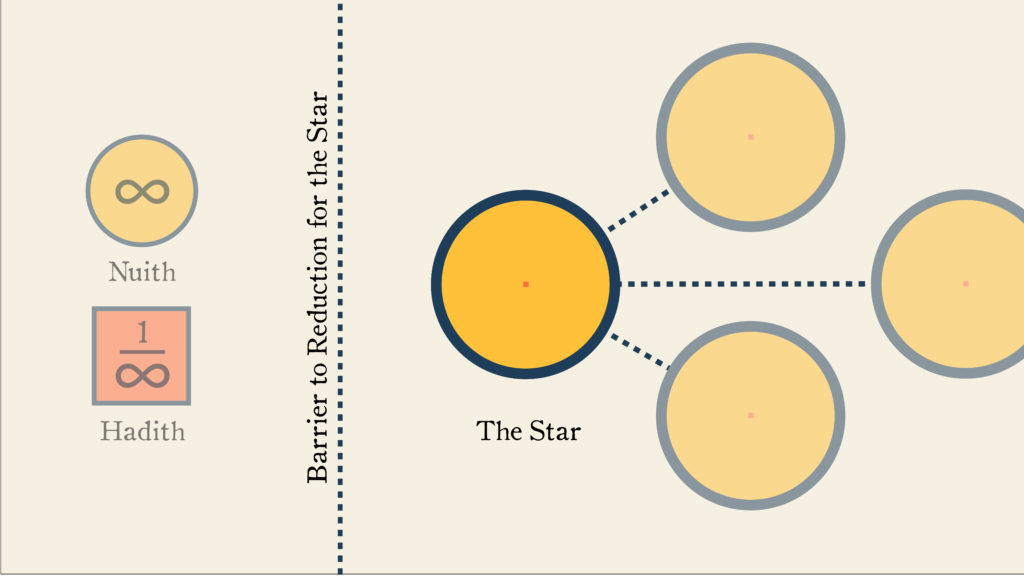
Derivability monism implies that the Star is aware that its “true nature [is a form] of the Infinite” (Ibid). As any particular triangle possesses all the principle attributes of a triangle, so does any Star possess all the principle attributes of its divine parents. This is just what it means that each Star is a mode of Nuith and Hadith, which themselves are modes of the Qabalistic Zero. We’re still dealing here with one divinity, just under three different forms: Zero, Nuith and Hadith, and the Star.
However, when we get to the level of the Star, there’s a fundamental difference. While the Star is technically part of a larger context (Nuith and Hadith) of which it is a mode, and while this fact is available to the Star, from the Star’s perspective, its own individuality as a Star is irreducible to that larger context.
We will return to this point and examine it in depth when we consider why it is the Star must incarnate.
Crowley’s Critique of Gnosticism
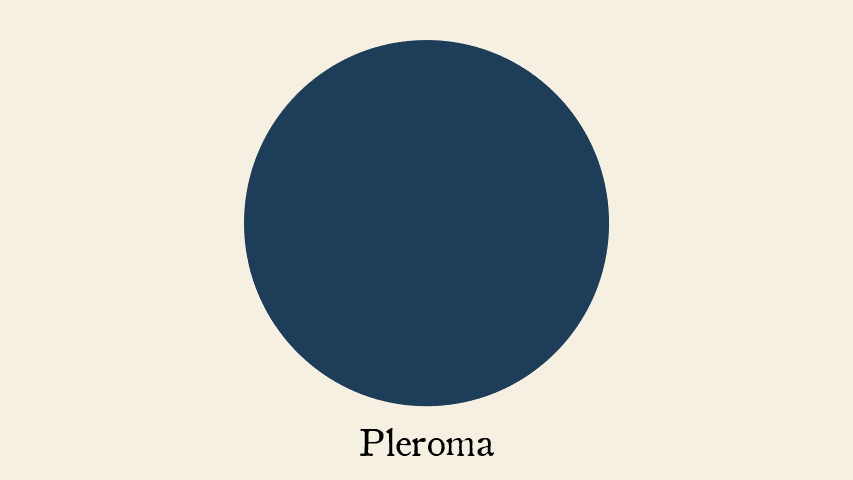
We are confronting an important point of difference between Thelema and any spiritual system according to which the “soul” is a “broken off” aspect of a higher, impersonal divine reality to which it “returns” either at death or spiritual attainment. Crowley targets Gnosticism in particular with committing this error when, commenting on AL I.8, he says:
Why are we told that the Khabs is in the Khu, not the Khu in the Khabs? Did we then suppose the converse? I think that we are warned against the idea of a Pleroma, a flame of which we are Sparks, and to which we return when we ‘attain’. That would indeed be to make the whole curse of separate existence ridiculous, a senseless and inexcusable folly.
New Comment on AL I.8
Pleroma is a Greek word (πλήρωμα) which literally means fullness. It is a technical term in the texts of Gnostic Christianity where it refers to the totality of divine powers. Crowley tended to think of it as an “impersonal unity” analogous to Brahma or Ain Soph. (See Crowley’s essay “Berashith,” passim.)
According to Gnostic cosmogony, the world we find ourselves in is outside of the pleroma. However, each individual carries a bit of the pleroma within themselves. If you find this pleroma within yourself, you can save yourself from a state of “deficiency” characteristic of the material world and restore yourself to an otherwise inaccessible sense of divine “fullness”.
Thus fullness [pleroma], which has no deficiency but fills up deficiency, is provided to fill a person’s need, so that the person may receive grace. While deficient, the person had no grace, and because of this a diminishing took place where there was no grace. When the diminished part was restored, the person in need was revealed as fullness.
The Gospel of Truth
Different Gnostic sects had different accounts of pleroma, different cosmogonies, and therefore different accounts of salvation, and it’s difficult to tell precisely which account Crowley had in mind when he made the pleroma remark. However, the contours of the general theory he’s critiquing are evident from the context.
He’s rejecting the idea that there is some original, undifferentiated, divine whole—”a flame”—of which each individual soul is a broken off part or “spark,” and he is rejecting the notion that salvation consists in abandoning one’s sense of separateness and reuniting with this whole.
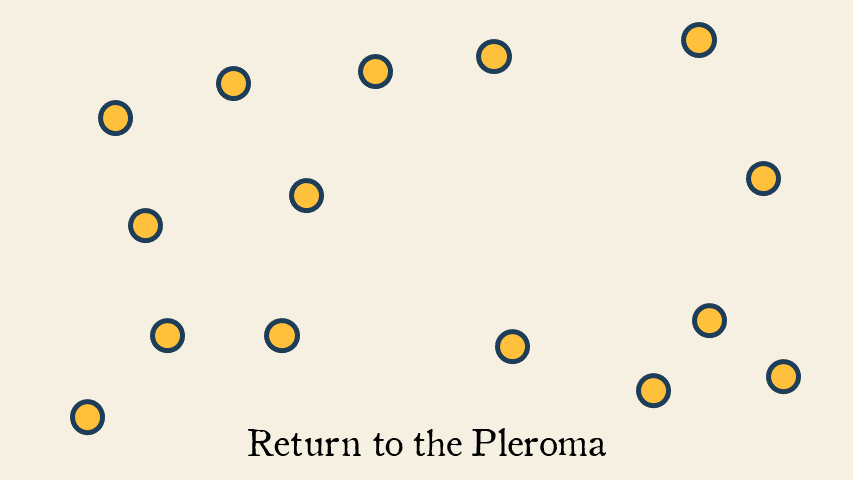
A full understanding of this critique will have to wait until we have analyzed the distinction between the Khabs and the Khu and thereby have a fuller understanding of incarnation, but even at this juncture it is possible to identify deep, fundamental differences between Gnosticism (and any analogous spirituality) and Thelema on the basis of Thelema’s metaphysics of the individual soul.
Gnosticism and Thelema share the idea that there is a modal distinction between the individual soul and the ultimate divine reality. Gnosticism describes the inner pleroma as a piece of the larger pleroma, and the Star within each individual is “a partial and divided aspect of” Nuith and Hadith. (New Comment on AL I.29)
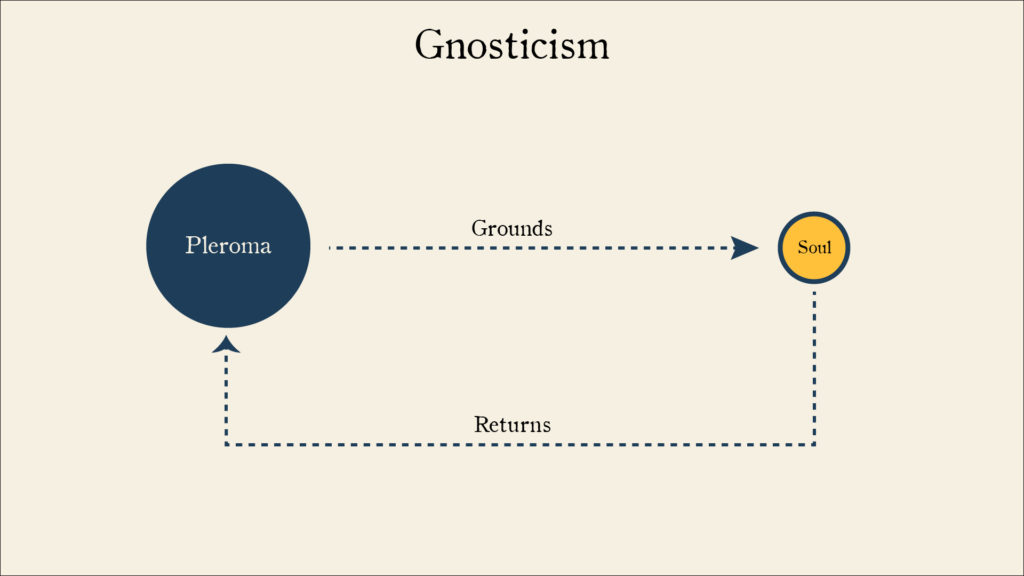
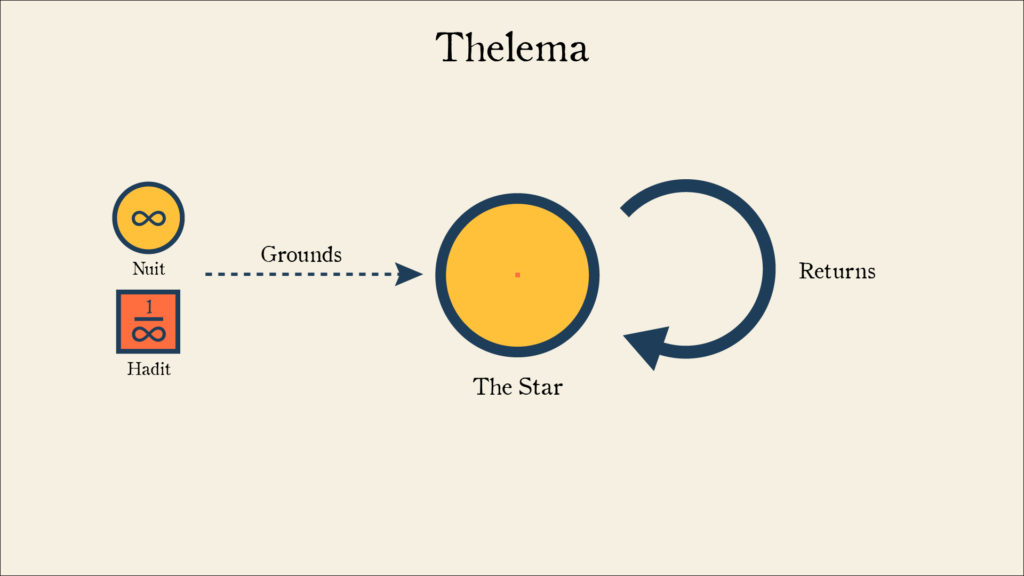
The difference is that the Star which is the essence of each individual is irreducible. To discover divinity within oneself does not mean the reduction of one’s individuality into an impersonal divine “flame,” because the very nature of the Star in principle prevents that reduction. Again, its derivation from a higher reality is only in principle possible but is never in fact possible for the Star.
It’s important to point out that this irreducibility of the Star to a more fundamental context has nothing whatsoever to do with our mode of sensibility (Nephesh) or the limitations of the discursive intellect (Ruach). If that were the case, then all of these distinctions would simply be rational distinctions. Rather, it follows from the primary attributes of the Star itself as reflected in Jechidah-Chiah-Neschamah.
We can see a similar point of contrast with what Crowley has called “mystic monism” or what we are calling identity monism. If Thelema were a form of identity monism, there would only hold a rational distinction between the Star and Nuith and Hadith. It would technically be an illusory distinction. Hence some explanation is required of the following passage in which Crowley himself describes this distinction as “illusory.”
[Nuith and Hadith] can only realize Themselves by creating an infinite variety of forms of Themselves, each one real as it is Their image, illusory as it is a partial and divided aspect of Them.New Comment on AL I.29 (emphasis mine)
We have to be careful with our terms here. From the perspective of Nuith and Hadith, it makes sense to say that the separation between them and any Star is “illusory,” but only in the sense that the Star does not constitute a separate substance from them. As we have seen, each Star is a mode of Nuith and Hadith.
Furthermore, from the perspective of Nuith and Hadith, there is no “mystery” in how the Star relates to them or other Stars. They could theoretically supply a reductive explanation of why each Star finds itself in the part of space it does, related to other Stars the way it is, etc.
From the Star’s perspective, the Star is also a mode of Nuith and Hadith; however, there is a mystery of exactly how it relates to the universe. But in neither case is Crowley merely making a rational distinction between Nuith, Hadith, and Stars.
The irreducibility of the Star is not an illusion it can unravel, nor is it an illusion it desires to unravel. It is already a “real image” of its parents and has all the primary divine attributes within itself. Even if the Star could somehow “dissolve” itself back into an undifferentiated, impersonal state, it would not gain anything from it.
The result is that, in Thelema, the individual as individual is the ultimate divine reality.
Deus est Homo

This is a fundamental characteristic of Thelema which differentiates it from other forms of spirituality.
Spiritual attainment entails the breakdown of illusory division and ends the sense of being cut off from divine reality, but the divine reality you’re being reunited with is none other than yourself. It’s your true will.
We don’t have the vantage point at this moment to fully articulate all the implications of this. Again, that will require an analysis of the distinction between the Khabs and the Khu. But we can already see that the derivability monism of the Star means that, from the perspective of the Star, the only reality that can ever mean anything for it is Itself.
The Star constitutes the pre-eminent reality of Thelemic spirituality. One’s individuality is as inescapable as it is irreducible. In principle, there can never be any higher reality for an individual than the individual him-or-herself. This is not a limitation on the Star but rather a condition of the expression of its divinity.
The Khu
Reflections on the Path in Eternity (Part 3)
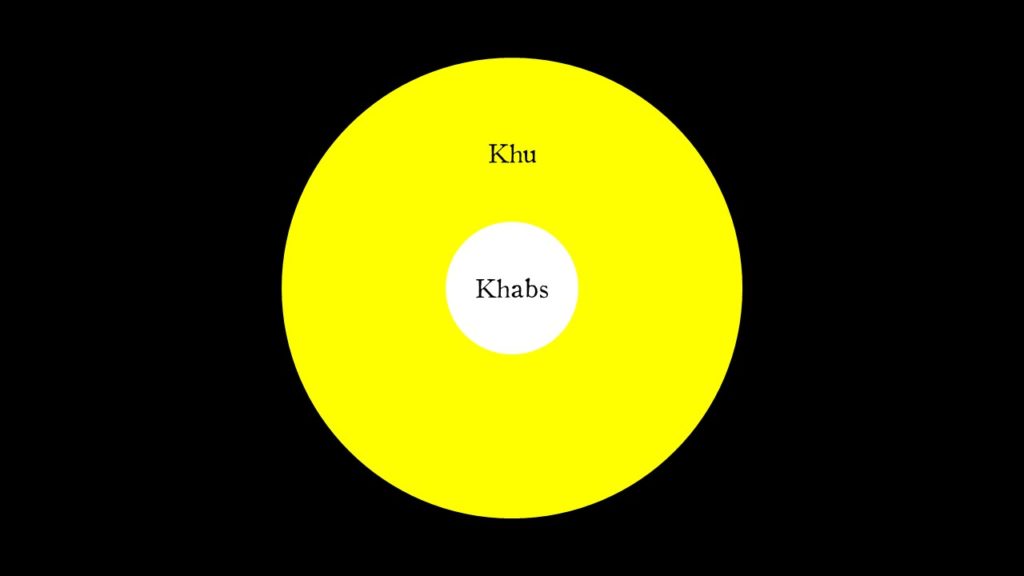
In the last post we saw that the star or soul of each individual is composed of two parts: the Khabs and the Khu. The Khabs is the manifestation of a distinct individual within the context of Nuit. The Khabs is the “house” of Hadit—your individual point of view—and as such it is the spiritual essence of who you are as an individual. We also saw that the Khabs is identical with the supernal triad on the Tree of Life, and as such it takes a triadic, reflective structure.
The Khu, on the other hand, is the “magical garment” of the star.
Khabs is the secret Light or L.V.X.; the Khu is the magical entity of a man […] This ‘star’ or ‘Inmost Light’ is the original, individual, eternal essence. The Khu is the magical garment which it weaves for itself, a ‘form’ for its Being Beyond Form, by use of which it can gain experience through self-consciousness
Old and New Comments on AL I.8
Each of us is Hadit, the core of our Khabs, our Star, one of the Company of Heaven; but this Khabs needs a Khu or Magical Image, in order to play its part in the Great Drama. This Khu, again, needs the proper costume, a suitable ‘body of flesh’, and this costume must be worthy of the Play.
New Comment on AL II.70
The Khabs represents the essence of who each of us is. It is possessed of the attributes of light, originality, individuality, and immortality. The Khu on the other hand is the mode by which the Khabs interacts with Nuit. If the Khabs is monistic (completely self-sufficient), the Khu is relational. It doesn’t exist without the interaction between the Khabs and Nuit.
And for that matter, the relationship between Khabs (or Hadit) and Nuit does not exist without the Khu. In other words, experience or embodiment of some kind is the necessary condition of the love “play” between Nuit and Hadit.
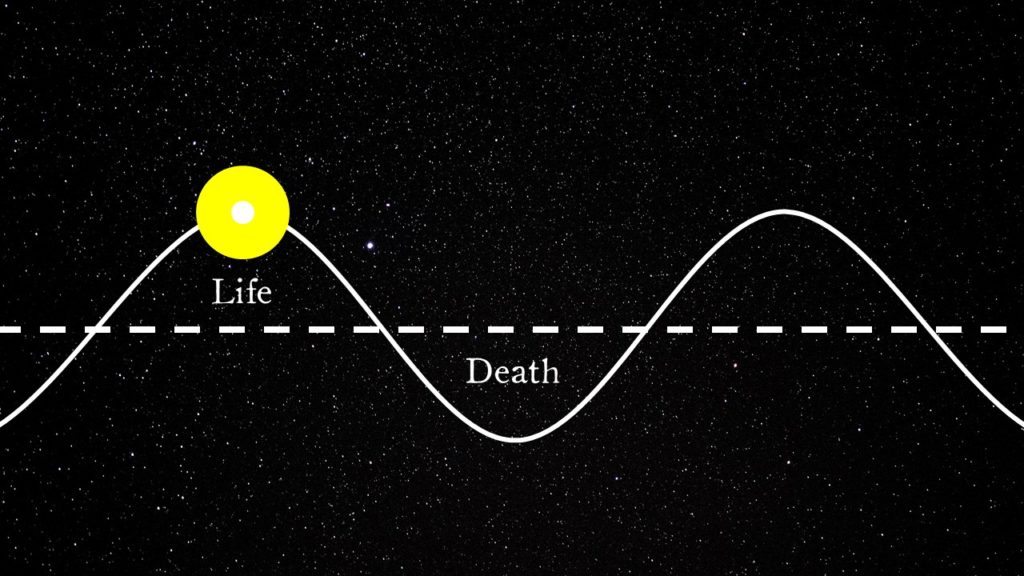
One answer to the question “Why do we incarnate?” is that incarnation (whether on this plane or some other) is a necessary precondition for Hadit’s going. In a subsequent post we can look at what some of the consequences of that are.
Unlike the Khabs of an individual which cannot be seen (arguably not even by the individual whose Khabs it is), since the Khu is relational, it is also manifest and can be seen either by the individual whose Khu it is or by others.
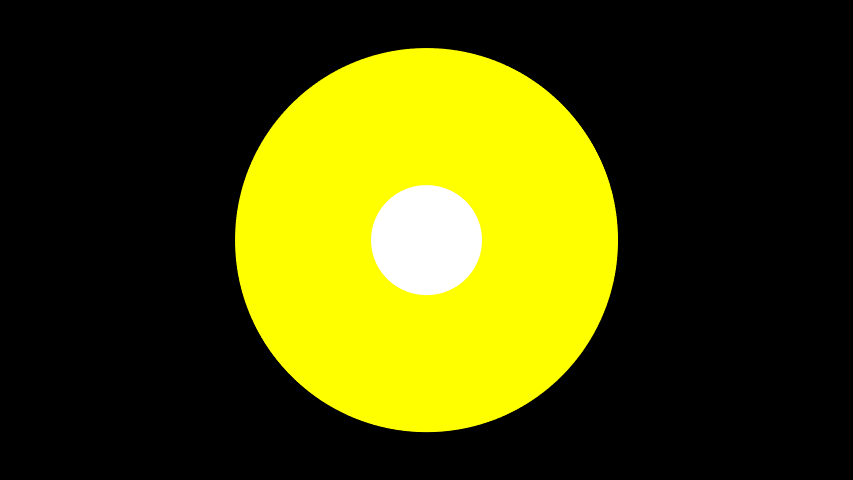
Also, since the Khu is a function of the interaction between the Khabs and Nuit, it is experiential and elastic. It grows and shrinks and changes in complexity in accordance with how much and what kind of experiences of Nuit one chooses to have.
“Every man and every woman is a star,” that is, an aggregate of such experiences, constantly changing with each fresh event, which affects him or her either consciously or subconsciously.
“Introduction” to the Book of the Law
the more complex the Khu of the Star, the greater the man, and the keener his sense of his need to achieve it.
New Comment on AL II.74
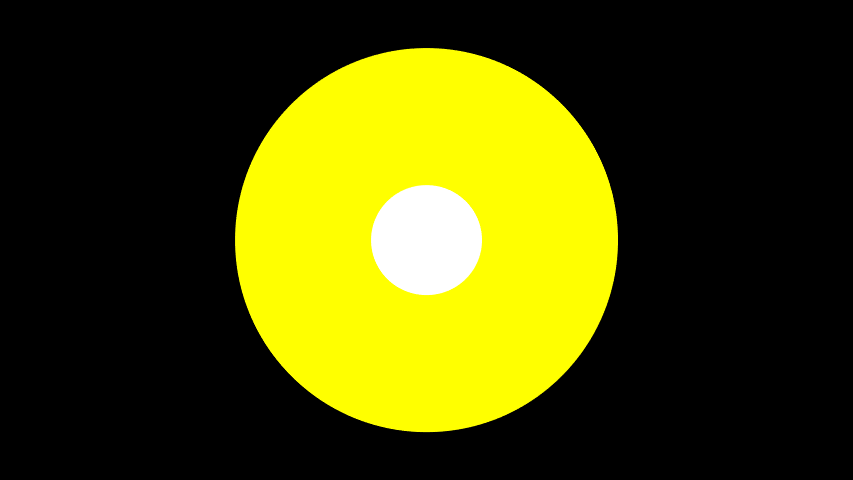
If the Khabs is the supernal triad on the Tree of Life, the Khu is composed of the subsequent seven sephiroth.
With each incarnation, the sephiroth below Binah are recreated anew, following the path of the Flaming Sword. At death, the lower sephiroth are jettisoned, and the essence of the Khabs is completely withdrawn back into the supernal triad.
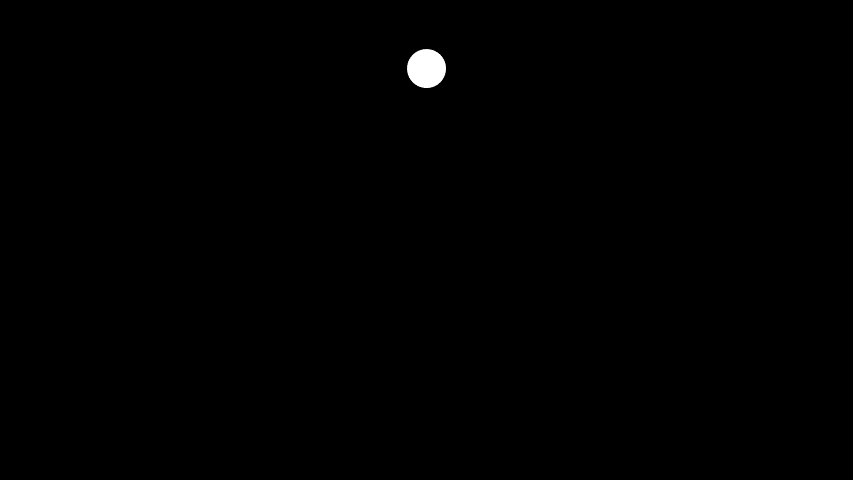
The exception to this is the individual who, through mystical and magical discipline, has opened and strengthened the pathways to their own Khabs.
[T]he Supernal Triad constitutes (or, rather, is an image of) the “eternal” Essence of a man [i.e., his Khabs]; that is, it is the positive expression of that ultimate “Point of View” which is and is not and neither is nor is not etc. Quite indestructible. Now when a man spends his life (a) building up and developing the six Sephiroth of the Ruach so that they cohere closely in proper balance and relation, (b) in forging, developing and maintaining a link of steel between this solid Ruach and that Triad, Death merely means the dropping off of the Nephesch (Malkuth) so that the man takes over his instrument of Mind (Ruach) with him to his next suitably chosen vehicle.Magick without Tears, chapter 38
Appear on the throne of Ra!
AL III.37
Open the ways of the Khu!
Lighten the ways of the Ka!

This is how the magical memory of a star can be built up over a series of incarnations.
This doctrine seems to imply that wisdom is not just passed down through the historical record but can also accumulate in certain stars on the Akashic plane.
Every star is already irreducibly individual and therefore unequal with any other star. But additionally it is also possible certain stars are “great beings” who, for reasons of having built up a magical memory over time, are possessed of extraordinary wisdom.
[C]ertain vast “stars” (or aggregates of experience) may be described as Gods. One of these is in charge of the destinies of this planet for periods of 2,000 years.“Introduction” to the Book of the Law
It’s possible Crowley understood this as the mechanism by which “Secret Chiefs” are created.
It would explain why he used names such as “Aiwass” and “V.V.V.V.V.” both as aspects of himself and as names of separate individuals. “Aleister Crowley” was merely the latest expression or mode (Khu) of an essence (Khabs) of which Aiwass and V.V.V.V.V. were others.
Crowley elaborates on metempsychosis in Liber Aleph, “De Adeptis R. C. Escatologia,” which should be studied closely by initiates of the III° of Mysteria Mystica Maxima.
But it is this continual extension and withdrawal of the Khu—and hence the relations of the Khabs with Nuit—which is visually depicted again and again in the movie.
What is Thelema?
Thelema is a religion founded in 1904 by the English poet and mystic, Aleister Crowley (1875-1947), who is regarded as its prophet. Those who follow the path of Thelema are called Thelemites.1
Thelema (Θελημα) is a Greek word for will, and the essential teaching of Thelema is “Do what thou wilt shall be the whole of the Law.” Of this teaching Crowley said,
“Do what thou wilt…” is to bid Stars to shine, Vines to bear grapes, Water to seek its level; man is the only being in Nature that has striven to set himself at odds with himself.2
From this we may infer that the essential teaching of Thelema is that each person ought to live in accordance with nature as expressed through their individual being. In this respect, Thelema is similar to Stoicism, Buddhism, or other religions which teach us to live according to the laws set by nature rather than God or human beings. Yet the Thelemic view of the universe according to Crowley differs in fundamental respects from what is taught in other religions and philosophies.
“Had! The manifestation of Nuit. The unveiling of the company of heaven.” (AL I.1-2)3
The foundation of Thelema is Liber AL vel Legis, which is Latin for Book AL or the Book of the Law.4
The Book of the Law was dictated to Aleister Crowley in Cairo, Egypt in 1904 by a spiritual being that called itself Aiwass. This book declared a new age for humanity, the Aeon of the Child, and proclaimed a new law for the conduct of all human beings: Do what thou wilt.
The universe described by the Book of the Law consists in two irreducible entities or concepts: the totality of possibilities of all kind, and any point of view on those possibilities. The first is symbolized by the Egyptian sky goddess, Nuit, and the second is represented by the Egyptian sun god, Hadit.5
“Every man and every woman is a star.” (AL I.3)
Experience arises when Hadit (the self of each individual) unites with some possibility inherent in Nuit (the spatiotemporal universe). Each person is “an aggregate of such experiences, constantly changing with each fresh event” or a star.6
Crowley describes each individual star or consciousness as an absolute monad: simple, utterly indestructible, as well as omnipotent, omniscient, and omnipresent. These are characteristics usually attributed to God, and indeed, Crowley taught that each star was the center and origin of its own universe.7
“For I am divided for love’s sake, for the chance of union.” (AL I.29)
Throughout our lives, and even throughout the course of a day, many events occur that imply oppositions or dualities. We experience pleasant versus unpleasant sensations, sorrowful versus happy occurrences, success versus failure in our endeavors, cruelty versus kindness in our actions, self versus world, self versus others, and many more. But the universe appears to us this way, because it is only by means of opposition that our Hadit or god-self can have experience and learn about itself. While each of us encounters constant opposition from the world and others, this opposition is both necessary and willed.8 From this, the supreme teaching of Thelema follows:9
“Do what thou wilt shall be the whole of the Law.” (AL I.40)
Crowley speaks of the will in two basic senses. On the one hand, each person has to discover for themselves what their purpose in life is. This could involve discovering which particular career or form of service suits your personality best and dedicating yourself wholeheartedly to it.10 It also means being free to express one’s individuality artistically and sexually, to work and to play as suits one’s own nature, and even to move across the face of the earth without interference from others.11 Crowley calls this the finite will or your will in the context of this life.12
Then there is your will in eternity or your infinite will, which is the will of Hadit—your true self—to explore every possibility available to itself, even across many incarnations. Crowley calls this the Great Work or the union of Hadit with Nuit.13
These need not be seen as two separate wills but rather two perspectives on the same will: the will seen from the perspective of this incarnation, where each moment presents us with the choice between doing our will versus not doing it, and the perspective of eternity, wherein every occurrence accords with our will, because every moment is necessary and perfect in and of itself.14
“Love is the law, love under will.” (AL I.57)
Every event whatsoever is an act of love, as each consists in the uniting of Hadit or the divine self of each individual with a possibility inherent in Nuit.15 While it is technically impossible not to do your will (seen from the infinite perspective), it is possible (from the finite perspective) to desire not to do your will, and from this arises suffering.16 It is therefore up to each of us to discover for ourselves what our true will is and to accept and desire to fulfill it rather than thwart it. Crowley calls the methods for achieving this magick.17
“Remember all ye that existence is pure joy; that all the sorrows are but as shadows; they pass & are done; but there is that which remains.” (AL II.9)
Since all events are acts of love under will, it follows that, at its very foundation, existence is joyful. Sorrow arises when we think of any two things as opposed to one another. Some one event pleases us so we call it “good,” and another is unpleasant so we call it “bad”. But they are all fundamentally “good,” because they are all the effect of Hadit loving Nuit, which itself is the natural result of each of us doing our will.18 This love of Hadit for Nuit eventually culminates in the union between the two which occurs at death, and therefore “death is the crown of all.”19
While there is more to Thelema than what is presented here, the rest are largely implications or practices intended to achieve these ideals. For further information, the reader is encouraged to explore the resources footnoted in this section.
1 https://oto-usa.org/thelema/
2 “Notes for an Astral Atlas,” in Magick in Theory and Practice (MITAP), Appendix III.
3 Chapters and verses of the Book of the Law are notated AL Chapter.Verse
4 AL is a Hebrew name for God.
5 Introduction to The Book of the Law (Intro).
6 Intro.
7 Intro and New Comment (NC) on AL I.3.
8 NC to AL I.29.
9 NC on AL I.3
10 MITAP (Introduction) and Liber CL (Section I).
11 Liber LXXVII.
12 Liber CL (Section I).
13 Ibid.
14 Intro.
15 Ibid.
16 NC on AL 1.51 and Liber CL.
17 Intro.
18 Djeridensis Comment on AL II.9.
19 NC on AL II.72.
References
- Crowley, Aleister. The Djeridensis Comment
- Crowley, Aleister. Liber CL
- Crowley, Aleister. Magick in Theory and Practice
- Crowley, Aleister. The New and Old Commentaries to Liber AL vel Legis, The Book of the Law
- Liber AL vel Legis sub figura CCXX with Introduction by Aleister Crowley
- United States Grand Lodge Ordo Templi Orientis



